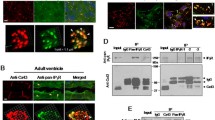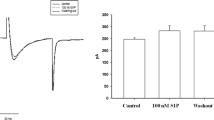Abstract
Changes in the lipid composition of cardiac myocytes have been reported during cardiac hypertrophy, cardiomyopathy, and infarction. Because a recent study indicates a relation between low phosphatidylinositol-bisphosphate (PIP2) levels and reduced intercellular coupling, we tested the hypothesis that agonist-induced changes in PIP2 can result in a reduction of the functional coupling of cardiomyocytes and, consequently, in changes in conduction velocity. Intercellular coupling was measured by Lucifer Yellow dye transfer in cultured neonatal rat cardiomyocytes. Conduction velocity was measured in cardiomyocytes grown on microelectrode arrays. Intercellular coupling was reduced by angiotensin II (43.7 ± 9.3%, N = 11) and noradrenaline (58.0 ± 10.7%, N = 11). To test if reduced intercellular coupling after agonist stimulation was caused by PIP2-depletion, myocytes were stimulated by angiotensin II (57.3 ± 5.7%, N = 14) and then allowed to recover in medium with or without wortmannin (an inhibitor of PIP2 synthesis). Intercellular coupling fully recovered in control medium (102.1 ± 8.9%, N = 10), whereas no recovery occurred in the presence of wortmannin (69.3 ± 7.8%, N = 12). Inhibition of PKC, calmodulin, or arachidonic acid production did not affect the response to either angiotensin II or noradrenaline. Furthermore, decreasing or increasing PIP2 also decreased and increased intercellular coupling, respectively. This supports the role of PIP2 in the regulation of intercellular coupling. In beating myocytes, conduction velocity was reduced by angiotensin II stimulation, and recovery after wash out was prevented by inhibition of PIP2 production. Reductions in PIP2 inhibit intercellular coupling in cardiomyocytes, and stimulation by physiologically relevant agonists reduces intercellular coupling by this mechanism. The reduction in intercellular coupling lowered conduction velocity.








Similar content being viewed by others
References
Axelsen LN, Stahlhut M, Mohammed S, Larsen BD, Nielsen MS, Holstein-Rathlou NH, Andersen S, Jensen ON, Hennan JK, Kjolbye AL (2006) Identification of ischemia-regulated phosphorylation sites in connexin43: A possible target for the antiarrhythmic peptide analogue rotigaptide (ZP123). J Mol Cell Cardiol 40:790–798
Bain J, Plater L, Elliott M, Shpiro N, Hastie CJ, McLauchlan H, Klevernic I, Arthur JS, Alessi DR, Cohen P (2007) The selectivity of protein kinase inhibitors: a further update. Biochem J 408:297–315
Banach K, Halbach MD, Hu P, Hescheler J, Egert U (2003) Development of electrical activity in cardiac myocyte aggregates derived from mouse embryonic stem cells. Am J Physiol Heart Circ Physiol 284:H2114–H2123
Beardslee MA, Lerner DL, Tadros PN, Laing JG, Beyer EC, Yamada KA, Kleber AG, Schuessler RB, Saffitz JE (2000) Dephosphorylation and intracellular redistribution of ventricular connexin43 during electrical uncoupling induced by ischemia. Circ Res 87:656–662
Bian J, Cui J, McDonald TV (2001) HERG K(+) channel activity is regulated by changes in phosphatidyl inositol 4,5-bisphosphate. Circ Res 89:1168–1176
Burt JM (1987) Block of intercellular communication: interaction of intracellular H + and Ca2+. Am J Physiol 253:C607–C612
Calloe K, Nielsen MS, Grunnet M, Schmitt N, Jorgensen NK (2007) KCNQ channels are involved in the regulatory volume decrease response in primary neonatal rat cardiomyocytes. Biochim Biophys Acta 1773:764–773
Carmeliet E (1999) Cardiac ionic currents and acute ischemia: from channels to arrhythmias. Physiol Rev 79:917–1017
Chau LY, Tai HH (1981) Release of arachidonate from diglyceride in human platelets requires the sequential action of a diglyceride lipase and a monoglyceride lipase. Biochem Biophys Res Commun 100:1688–1695
Clerk A, Sugden PH (1997) Regulation of phospholipases C and D in rat ventricular myocytes: stimulation by endothelin-1, bradykinin and phenylephrine. J Mol Cell Cardiol 29:1593–1604
Davidson JS, Baumgarten IM (1988) Glycyrrhetinic acid derivatives: a novel class of inhibitors of gap-junctional intercellular communication. Structure–activity relationships. J Pharmacol Exp Ther 246:1104–1107
De Mello WC (1996) Renin–angiotensin system and cell communication in the failing heart. Hypertension 27:1267–1272
Dent MR, Dhalla NS, Tappia PS (2004) Phospholipase C gene expression, protein content, and activities in cardiac hypertrophy and heart failure due to volume overload. Am J Physiol Heart Circ Physiol 287:H719–H727
Dhein S, Larsen BD, Petersen JS, Mohr FW (2003) Effects of the new antiarrhythmic peptide ZP123 on epicardial activation and repolarization pattern. Cell Commun Adhes 10:371–378
Doble BW, Ping P, Kardami E (2000) The ε subtype of protein kinase C is required for cardiomyocyte connexin-43 phosphorylation. Circ Res 86:293–301
Egert U, Knott T, Schwarz C, Nawrot M, Brandt A, Rotter S, Diesmann M (2002) MEA-Tools: an open source toolbox for the analysis of multi-electrode data with MATLAB. J Neurosci Methods 117:33–42
Ek-Vitorin JF, King TJ, Heyman NS, Lampe PD, Burt JM (2006) Selectivity of connexin 43 channels is regulated through protein kinase C-dependent phosphorylation. Circ Res 98:1498–1505
Enomoto T, Yamasaki H (1985) Phorbol ester-mediated inhibition of intercellular communication in BALB/c 3T3 cells: relationship to enhancement of cell transformation. Cancer Res 45:2681–2688
Fluri GS, Rudisuli A, Willi M, Rohr S, Weingart R (1990) Effects of arachidonic acid on the gap junctions of neonatal rat heart cells. Pflugers Arch 417:149–156
Halbach M, Egert U, Hescheler J, Banach K (2003) Estimation of action potential changes from field potential recordings in multicellular mouse cardiac myocyte cultures. Cell Physiol Biochem 13:271–284
Hilgemann DW, Ball R (1996) Regulation of cardiac Na+,Ca2+ exchange and KATP potassium channels by PIP2. Science 273:956–959
Huang CL, Feng S, Hilgemann DW (1998) Direct activation of inward rectifier potassium channels by PIP2 and its stabilization by Gbetagamma. Nature 391:803–806
Kaplinsky E, Ogawa S, Balke CW, Dreifus LS (1979) Two periods of early ventricular arrhythmia in the canine acute myocardial infarction model. Circulation 60:397–403
Kem DC, Johnson EI, Capponi AM, Chardonnens D, Lang U, Blondel B, Koshida H, Vallotton MB (1991) Effect of angiotensin II on cytosolic free calcium in neonatal rat cardiomyocytes. Am J Physiol 261:C77–C85
Kleber AG, Riegger CB, Janse MJ (1987) Electrical uncoupling and increase of extracellular resistance after induction of ischemia in isolated, arterially perfused rabbit papillary muscle. Circ Res 61:271–279
Kwak BR, van Veen TA, Analbers LJS, Jongsma HJ (1995) TPA increases conductance but decreases permeability in neonatal rat cardiomyocyte gap junction channels. Exp Cell Res 220:456–463
Lampe PD, Lau AF (2004) The effects of connexin phosphorylation on gap junctional communication. Int J Biochem Cell Biol 36:1171–1186
Lampe PD, TenBroek EM, Burt JM, Kurata WE, Johnson RG, Lau AF (2000) Phosphorylation of connexin43 on serine368 by protein kinase C regulates gap junctional communication. J Cell Biol 149:1503–1512
Liu SY, Yu CH, Hays JA, Panagia V, Dhalla NS (1997) Modification of heart sarcolemmal phosphoinositide pathway by lysophosphatidylcholine. Biochim Biophys Acta 1349:264–274
Loussouarn G, Park KH, Bellocq C, Baro I, Charpentier F, Escande D (2003) Phosphatidylinositol-4,5-bisphosphate, PIP2, controls KCNQ1/KCNE1 voltage-gated potassium channels: a functional homology between voltage-gated and inward rectifier K+ channels. EMBO J 22:5412–5421
Lurtz MM, Louis CF (2007) Intracellular calcium regulation of connexin43. Am J Physiol Cell Physiol 293:C1806–C1813
Mackay K, Mochly-Rosen D (2001) Localization, anchoring, and functions of protein kinase C isozymes in the heart. J Mol Cell Cardiol 33:1301–1307
Massey KD, Minnich BN, Burt JM (1992) Arachidonic acid and lipoxygenase metabolites uncouple neonatal rat cardiac myocyte pairs. Am J Physiol 263:C494–C501
Maurer P, Weingart R (1987) Cell pairs isolated from adult guinea pig and rat hearts: effects of [Ca2+]i on nexal membrane resistance. Pflugers Arch 409:394–402
Mesaeli N, Tappia PS, Suzuki S, Dhalla NS, Panagia V (2000) Oxidants depress the synthesis of phosphatidylinositol 4,5-bisphosphate in heart sarcolemma. Arch Biochem Biophys 382:48–56
Mouton R, Huisamen B, Lochner A (1991) The effect of ischaemia and reperfusion on sarcolemmal inositol phospholipid and cytosolic inositol phosphate metabolism in the isolated perfused rat heart. Mol Cell Biochem 105:127–135
Nakanishi S, Catt KJ, Balla T (1995) A wortmannin-sensitive phosphatidylinositol 4-kinase that regulates hormone-sensitive pools of inositolphospholipids. Proc Natl Acad Sci U S A 92:5317–5321
Nasuhoglu C, Feng S, Mao Y, Shammat I, Yamamato M, Earnest S, Lemmon M, Hilgemann DW (2002) Modulation of cardiac PIP2 by cardioactive hormones and other physiologically relevant interventions. Am J Physiol Cell Physiol 283:C223–C234
Noma A, Tsuboi N (1987) Dependence of junctional conductance on proton, calcium and magnesium ions in cardiac paired cells of guinea-pig. J Physiol (Lond) 382:193–211
Penny WJ (1984) The deleterious effects of myocardial catecholamines on cellular electrophysiology and arrhythmias during ischaemia and reperfusion. Eur Heart J 5:960–973
Postma FR, Hengeveld T, Alblas J, Giepmans BN, Zondag GC, Jalink K, Moolenaar WH (1998) Acute loss of cell-cell communication caused by G protein-coupled receptors: a critical role for c-Src. J Cell Biol 140:1199–1209
Powis G, Bonjouklian R, Berggren MM, Gallegos A, Abraham R, Ashendel C, Zalkow L, Matter WF, Dodge J, Grindey G (1994) Wortmannin, a potent and selective inhibitor of phosphatidylinositol-3-kinase. Cancer Res 54:2419–2423
Raptis LH, Brownell HL, Firth KL, MacKenzie LW (1994) A novel technique for the study of intercellular, junctional communication: electroporation of adherent cells on a partly conductive slide. DNA Cell Biol 13:963–975
Sheridan DJ, Penkoske PA, Sobel BE, Corr PB (1980) Alpha adrenergic contributions to dysrhythmia during myocardial ischemia and reperfusion in cats. J Clin Invest 65:161–171
Simpson P, Savion S (1982) Differentiation of rat myocytes in single cell cultures with and without proliferating nonmyocardial cell. Cross-striations, ultrastructure, and chronotropic response to isoproterenol. Circ Res 50:101–116
Smith WT, Fleet WF, Johnson TA, Engle CL, Cascio WE (1995) The Ib phase of ventricular arrhythmias in ischemic in situ porcine heart is related to changes in cell-to-cell electrical coupling. Experimental Cardiology Group, University of North Carolina. Circulation 92:3051–3060
Suh BC, Hille B (2005) Regulation of ion channels by phosphatidylinositol 4,5-bisphosphate. Curr Opin Neurobiol 15:370–378
Suh BC, Inoue T, Meyer T, Hille B (2006) Rapid chemically induced changes of PtdIns(4,5)P2 gate KCNQ ion channels. Science 314:1454–1457
Tappia PS, Liu SY, Shatadal S, Takeda N, Dhalla NS, Panagia V (1999) Changes in sarcolemmal PLC isoenzymes in postinfarct congestive heart failure: partial correction by imidapril. Am J Physiol 277:H40–H49
Touyz RM, Fareh J, Thibault G, Tolloczko B, Lariviere R, Schiffrin EL (1996) Modulation of Ca2+ transients in neonatal and adult rat cardiomyocytes by angiotensin II and endothelin-1. Am J Physiol 270:H857–H868
van Zeijl L, Ponsioen B, Giepmans BN, Ariaens A, Postma FR, Varnai P, Balla T, Divecha N, Jalink K, Moolenaar WH (2007) Regulation of connexin43 gap junctional communication by phosphatidylinositol 4,5-bisphosphate. J Cell Biol 177:881–891
Verkerk AO, Veldkamp MW, Coronel R, Wilders R, van Ginneken AC (2001) Effects of cell-to-cell uncoupling and catecholamines on Purkinje and ventricular action potentials: implications for phase-1b arrhythmias. Cardiovasc Res 51:30–40
Weng S, Lauven M, Schaefer T, Polontchouk L, Grover R, Dhein S (2002) Pharmacological modification of gap junction coupling by an antiarrhythmic peptide via protein kinase C activation. FASEB J 16:1114–1116
Winks JS, Hughes S, Filippov AK, Tatulian L, Abogadie FC, Brown DA, Marsh SJ (2005) Relationship between membrane phosphatidylinositol-4,5-bisphosphate and receptor-mediated inhibition of native neuronal M channels. J Neurosci 25:3400–3413
Wu J, McHowat J, Saffitz JE, Yamada KA, Corr PB (1993) Inhibition of gap junctional conductance by long-chain acylcarnitines and their preferential accumulation in junctional sarcolemma during hypoxia. Circ Res 72:879–889
Yamamoto M, Chen MZ, Wang YJ, Sun HQ, Wei Y, Martinez M, Yin HL (2006) Hypertonic stress increases phosphatidylinositol 4,5-bisphosphate levels by activating PIP5KIbeta. J Biol Chem 281:32630–32638
Zhang H, He C, Yan X, Mirshahi T, Logothetis DE (1999) Activation of inwardly rectifying K+ channels by distinct PtdIns(4,5)P2 interactions. Nat Cell Biol 1:183–188
Ziegelhoffer A, Tappia PS, Mesaeli N, Sahi N, Dhalla NS, Panagia V (2001) Low level of sarcolemmal phosphatidylinositol 4,5-bisphosphate in cardiomyopathic hamster (UM-X7.1) heart. Cardiovasc Res 49:118–126
Acknowledgement
We thank Professor Donald Marsh for valuable suggestions and comments to the manuscript. Ninna Buch Petersen and Trine Eidsvoll are thanked for excellent technical assistance.
Grants
This work was supported by: The Danish National Research Foundation; The John and Birthe Meyer Foundation; The Danish Natural and Health Sciences Research Councils; The Velux Foundation; The Danish Heart Association; The Novo Nordisk Foundation; The A.P. Møller Foundation.
Disclosures
There are no conflicts of interest.
Author information
Authors and Affiliations
Corresponding author
Rights and permissions
About this article
Cite this article
Hofgaard, J.P., Banach, K., Mollerup, S. et al. Phosphatidylinositol-bisphosphate regulates intercellular coupling in cardiac myocytes. Pflugers Arch - Eur J Physiol 457, 303–313 (2008). https://doi.org/10.1007/s00424-008-0538-x
Received:
Revised:
Accepted:
Published:
Issue Date:
DOI: https://doi.org/10.1007/s00424-008-0538-x




